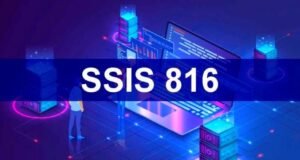SQL Server Integration Services (SSIS) remains a cornerstone for data professionals who require a powerful tool to manage complex data transformation and integration needs. This article delves deep into SSIS 816, a robust version within the Microsoft SQL Server suite, exploring its components, functionalities, integration capabilities, and future prospects in the era of big data and cloud computing.
Understanding SSIS 816
What is SSIS 816?
SSIS 816 is part of the broader Microsoft SQL Server suite designed to facilitate efficient data integration and transformation processes. This version of SSIS is especially significant due to its enhanced capabilities in handling complex workflows and larger datasets, making it an invaluable tool for developers and IT professionals dealing with extensive data management tasks.
Core Purpose and Benefits
The primary function of SSIS 816 is to execute data movement and cleaning operations through a process known as Extract, Transform, Load (ETL). It provides a scalable platform that supports data collection from various sources, transforms the data according to business rules, and loads it into different destination formats. The benefits of using SSIS 816 include improved data consistency, extensive support for integration with other Microsoft products, and a comprehensive set of features for error handling and performance tuning.
Key Components of SSIS 816

SSIS Designer
The SSIS Designer is an intuitive graphical interface that allows users to build and manage integration workflows efficiently. This tool includes a variety of built-in tasks and transformations that can be configured to meet specific ETL requirements, making it easier for users to design data workflows without extensive coding.
Control Flow
The Control Flow acts as the brain of an SSIS package. It manages the sequence of tasks and workflows, including data flow operations, script execution, and file transfers. The Control Flow allows for conditional logic, looping, and task branching, which provides flexibility and precise control over complex processing sequences.
Data Flow
Data Flow is a critical component where data is transformed as it moves from source to destination. It utilizes different types of transformations, such as sorting, aggregating, merging, and cleansing data. This component is vital for ensuring that data is correctly formatted and clean before it’s loaded into its end location.
Event Handlers and Error Management
Effective error handling is essential in ETL processes, where the cost of data inconsistencies can be high. SSIS 816 offers robust error handling and event management features that help developers and administrators manage errors gracefully and log events for later analysis.
Integration and Compatibility

Integration with Other SQL Server Tools
SSIS 816 seamlessly integrates with SQL Server Management Studio (SSMS) and SQL Server Data Tools (SSDT), enhancing its usability and allowing for a more streamlined workflow. This integration enables users to use familiar interfaces and tools to develop, test, and deploy SSIS solutions efficiently.
Compatibility with Cloud and Big Data Solutions
With the increasing adoption of cloud services and big data platforms, SSIS 816 has evolved to support Azure and other cloud-based data sources. This ensures that SSIS can handle data integration tasks across diverse environments, including traditional on-premises and modern cloud infrastructures.
Deployment and Execution Strategies
Deploying SSIS Packages
Deploying SSIS packages efficiently is crucial for maintaining the reliability of data workflows. SSIS 816 includes features that simplify the deployment process across different servers and environments, allowing for scalable ETL processes that can be updated or modified with minimal downtime.
Executing SSIS Packages
SSIS packages can be executed in various ways, including manually, scheduled as a job using SQL Server Agent, or triggered by external events. Efficient execution strategies are crucial for ensuring that data loads are performed within expected time frames and without errors.
Advanced Features and Customizations

Custom Components and Tasks
SSIS is highly extensible, allowing developers to create custom components and tasks if the built-in functionalities do not meet their specific requirements. This flexibility is one of the strengths of SSIS, enabling it to adapt to a wide range of data integration needs.
Performance Tuning and Optimization
Tuning SSIS for optimal performance involves understanding and optimizing the data flows and transformations. SSIS 816 provides tools and performance counters that help identify bottlenecks and optimize data throughput, essential for handling large volumes of data efficiently.
The Future of SSIS 816
As data volumes continue to grow and integration needs become more complex, SSIS 816 is expected to evolve further, incorporating more advanced features for cloud integration, real-time data processing, and artificial intelligence (AI). These advancements will ensure that SSIS remains a relevant and powerful tool for data integration challenges.
Conclusion
SSIS 816 is a comprehensive tool for managing complex data integration tasks effectively. Whether you are a seasoned IT professional or a newcomer to data management, understanding and utilizing SSIS can significantly enhance your data handling capabilities. For more in-depth insights and resources on SSIS 816, exploring dedicated SQL Server documentation and community forums is recommended.
FAQs About SSIS 816
What is SSIS 816?
SSIS 816, or SQL Server Integration Services 816, is a version of Microsoft’s data integration and workflow automation tool, part of the SQL Server suite. It is designed to facilitate complex data transformations and the integration of different types of data systems.
Who should use SSIS 816?
SSIS 816 is ideal for database administrators, ETL developers, and data professionals who need to handle large volumes of data and complex data integration scenarios. It’s particularly useful in environments where there are requirements to integrate SQL Server data with other databases or applications.
What are the key features of SSIS 816?
Key features of SSIS 816 include:
- Data Flow Transformations: Allows for complex data transformations and combinations.
- Control Flow: Manages the order of execution and logic for tasks within an SSIS package.
- Error Handling: Robust mechanisms to manage and resolve errors during execution.
- Custom Components: Ability to extend functionality by creating custom tasks and components.
- Integration with SQL Server: Seamless operation with other SQL Server components like SQL Server Management Studio and SQL Server Data Tools.
How does SSIS 816 handle data transformation?
SSIS 816 handles data transformation through its Data Flow task, which includes a variety of built-in components that perform different transformations. These transformations can sort, merge, convert, and aggregate data, allowing it to be prepared for analysis or loaded into different destinations.
Can SSIS 816 connect to data sources outside of SQL Server?
Yes, SSIS 816 can connect to a wide range of data sources, including Oracle, MySQL, PostgreSQL, flat files, and XML files. It also supports connections to cloud services like Azure Blob Storage and Amazon S3, making it a versatile tool for data integration across diverse environments.
How is SSIS 816 deployed?
SSIS 816 packages can be deployed using the SSIS Deployment Wizard or manually by exporting packages to the Integration Services server. Deployment can also be automated through scripts or implemented via SQL Server Management Studio for ease of management.
What are the best practices for optimizing SSIS 816 performance?
Optimizing SSIS 816 performance typically involves:
- Minimizing the use of synchronous transformations.
- Using blocking transformations judiciously.
- Optimizing the data flow by adjusting buffer sizes.
- Employing parallel processing where appropriate.
- Regularly monitoring performance and adjusting as needed.
Does SSIS 816 support real-time data integration?
While SSIS 816 is primarily designed for batch processing, it can be configured to handle near-real-time data integration using triggers or polling mechanisms. For true real-time processing, other tools may need to be considered in conjunction with or instead of SSIS.
What are the common challenges when using SSIS 816?
Some common challenges include managing memory usage in large data flows, debugging complex packages, handling data quality issues, and integrating SSIS with other non-Microsoft products. Proper planning, testing, and monitoring can mitigate many of these challenges.
Where can I find resources to learn more about SSIS 816?
Resources for learning about SSIS 816 are available through Microsoft’s official documentation, SQL Server Integration Services blogs, community forums, and training platforms like Pluralsight, LinkedIn Learning, and Udemy. These resources offer tutorials, case studies, and best practice guides that can enhance your understanding and skills.

















Leave a Reply